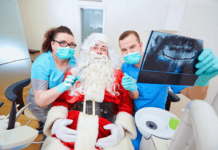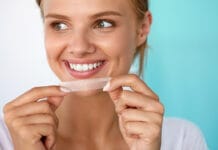Dental professionals spend a lot of time educating patients on products and methods to prevent dental decay. Although most dental hygienists recommend topical fluoride products, some patients refuse to use fluoride due to misinformation or personal beliefs.
While educating dental patients about the scientifically proven benefits of topical fluoride is always important, dental professionals need to accommodate patients looking for alternatives to fluoride for caries prevention. Some alternatives are reviewed in this article.
Xylitol
My first recommendation to patients who resist fluoride is xylitol products. Patients love to hear that xylitol is a naturally occurring sugar alcohol found in plants and agricultural materials.1,9 When used in proper doses, xylitol disrupts energy production in cariogenic bacteria such as S. mutans, causing the cariogenic bacteria to die. Additionally, it reduces the levels of S. mutans in plaque and saliva by up to 90%, further reducing the risk of caries.2,3
Xylitol also neutralizes the pH level in the mouth by absorbing into the saliva. However, this effect is only seen for up to 30 minutes, which is why using xylitol-containing products after a high-carbohydrate meal or snack is beneficial in reducing the risk of developing dental caries.2,10
In order to get the benefit of caries prevention, patients need to understand that they have to consume at least 8 grams of xylitol twice a day and no more than 40 grams daily to reduce the risk of gastrointestinal upset. Though you can safely consume up to 40 grams, studies indicate more than 8 grams shows a plateau effect; therefore, more is not necessarily better in the case of xylitol for caries prevention.3 I recommend reminding patients that too much of a good thing can be bad, and overconsumption of xylitol can cause digestive upset.
Many products have xylitol in them, including toothpaste, gum, lozenges, mouth rinses, and even sugar substitutes patients can add to their daily routine or diet. A few brands on the market have higher concentrations of xylitol in their products, and I prefer to recommend these to patients to make their daily goal of at least 8 grams easier to achieve.
To ensure patients get the recommended dose, simply have them read the nutritional label on the product. Knowing this information and giving detailed instructions to the patient when you recommend a product will likely increase compliance.
It may be helpful to mention to patients who are interested in trying xylitol products that they must be sure to keep the products away from their pets. Xylitol has toxic effects on many animal species. As a rule, it is best to keep these products away from all animals to prevent an emergency visit to your veterinarian.4,14 It is important to note that xylitol can be found in food products such as peanut butter and ice cream. For your pet’s safety, keep all products containing xylitol secure.
Nano-hydroxyapatite
Another alternative to fluoride use is nano-hydroxyapatite, which has been shown to have remineralization effects on enamel. Hydroxyapatite is the main component of enamel, but it can also be found in bone and saliva.5 It is naturally occurring in the human body.
The synthetic version of hydroxyapatite is nano-hydroxyapatite (nano-HA), which has been shown to be safe and effective for preventative, restorative, and periodontal, oral, and maxillofacial surgery.5 Nano-Ha is nearly identical to the hydroxyapatite found naturally in the body, which makes it non-toxic.5
In some countries, such as Japan, nano-HA is the gold standard for caries prevention and enamel remineralization. Some studies show nano-HA has been proven to be superior to fluoride for remineralization on initial lesions in enamel, making it an excellent substitute for patients looking for fluoride alternatives.5
Many types of toothpaste available contain nano-HA that can be recommended to patients for daily use. A toothpaste with 10% nano-HA has been shown to be just as effective as fluoridated toothpaste for the prevention of caries.5 Nano-HA is also an effective desensitizing agent, and many patients experience relief within two to four weeks when applied to sensitive teeth for 10 minutes twice a day.6,11
Arginine
Arginine is an amino acid that is found in the saliva and has been shown to raise the pH of the oral cavity. Arginine metabolism creates ammonia which contributes to pH homeostasis and ecological balance of biofilms, reducing the risk of caries development.
Some studies show that the use of arginine toothpaste can be more effective at caries prevention than the fluoride toothpaste control used.7 In a 2-year clinical study published in 2005, the authors evaluated the effectiveness of caries inhibition using a 1.5% arginine fluoride-free toothpaste versus fluoride toothpaste. They found that arginine-containing toothpaste was more effective than fluoride toothpaste.7,12
There are a few concerns regarding the use of arginine. There is some evidence that long-term use of arginine products could play a role in the pathogenesis of periodontal disease.7 Arginine supplements are not recommended for patients with a recent heart attack and can worsen allergies or asthma. Arginine supplements may also trigger latent viruses such as herpes simplex.13
It is important to consider drug interactions when recommending arginine products as there are possible drug interactions. Review these interactions, and discuss them with your patient and your patient’s physician.13 Additionally, there are not many products on the market that contain arginine, but companies claim that more are in the process of being developed.
Theobromine
Theobromine is made from cocoa bean husk. Studies show that theobromine has been shown to be effective in the prevention of carious lesions, as well as remineralization. The mechanism of action is not well understood, but theobromine is highly effective at reducing S. mutans and plaque formation, lending to its anticaries properties.17
Theobromine can easily be absorbed into the human body and used by the body with few side effects. Side effects associated with theobromine are like the effects of caffeine and include increased heart rate and alertness; this occurs at higher doses. The dose at which these side effects would occur is unlikely to happen with the doses used in toothpaste.8,15 However, as with arginine products, theobromine products can be difficult for patients to find and utilize.
As with xylitol, a disclaimer to patients with pets, theobromine is toxic to some animal species. Therefore, advise all patients with pets to keep any product containing theobromine secure and away from them at all times.16
In Closing
Patients require individualized treatment and home care options. Some patients prefer fluoride-free options, and we need to be prepared with recommendations for those patients. Xylitol, arginine, and theobromine are fluoride-free alternatives for patients opposed to the standard fluoride toothpaste recommendation. Together, we can help our patients determine which option suits their needs best and recommend products that fit their needs.
Before you leave, check out the Today’s RDH self-study CE courses. All courses are peer-reviewed and non-sponsored to focus solely on pure education. Click here now.
Listen to the Today’s RDH Dental Hygiene Podcast Below:
References
- Sollid, K. (2019, January 3). What is Xylitol? International Food Information Council Foundation. https://foodinsight.org/what-is-xylitol/
- If Your Dentist Doesn’t Recommend Xylitol Based Products, Get A New One! (n.d.). Xylitol. https://xylitol.org/xylitol-uses/dental-benefits-of-xylitol/
- Nayak, P.A., Nayak, U.A., Khandelwal, V. The Effect of Xylitol on Dental Caries and Oral Flora. Clinical, Cosmetic and Investigational Dentistry. 2014; 2014(6): 89-94. https://doi.org/10.2147/CCIDE.S55761
- Paws Off Xylitol, It’s Dangerous for Dogs. (2021, July 7). U.S. Food and Drug Administration. https://www.fda.gov/consumers/consumer-updates/paws-xylitol-its-dangerous-dogs
- Pepla, E., Besharat, L.K., Palaia, G., et al. Nano-Hydroxyapatite and Its Applications in Preventive, Restorative and Regenerative Dentistry: A Review of Literature. Ann Stomatol (Roma). 2014; 5(3): 108-114. https://www.ncbi.nlm.nih.gov/pmc/articles/PMC4252862/
- O’Hagan-Wong, K., Enax, J., Meyer, F., Ganss, B. The Use of Hydroxyapatite Toothpaste to Prevent Dental Caries. Odontology. 2021; 110: 223-230. https://doi.org/10.1007/s10266-021-00675-4
- Nascimento, M.M., Potential Uses of Arginine in Dentistry. Advances in Dental Research. 2018; 29(1): 98-103. https://doi.org/10.1177/0022034517735294
- Durhan, M.A., Bisel, S.O., Gokkaya, B., et al. Caries Preventive Effects of Theobromine Containing Toothpaste on Early Childhood Caries: Preliminary Results. Acta Stomatologica Croatica. 2021; 55(1): 18-27. https://doi.org/10.15644/asc55/1/3
- Janakiram, C., Deepan Kumar, C.V., Joseph, J. Xylitol in Preventing Dental Caries: A Systematic Review and Meta-analyses.Journal of Natural Science, Biology, and Medicine. 2017;8(1): 16-21. https://doi.org/10.4103/0976-9668.198344
- Lif Holgerson, P., Stecksén-Blicks, C., Sjöström, I., et al. Xylitol Concentration in Saliva and Dental Plaque after use of Carious Xylitol-containing Products.Caries Research. 2006;40(5): 393-397. https://doi.org/10.1159/000094284
- Vano, M., Derchi, G., Barone, A., et al. Reducing Dentine Hypersensitivity with Nano-hydroxyapatite Toothpaste: A Double-blind Randomized Controlled Trial.Clinical Oral Investigations. 2018;22(1): 313-320. https://doi.org/10.1007/s00784-017-2113-3
- Acevedo, A.M., Machado, C., Rivera, L.E., et al. The Inhibitory Effect of an Arginine Bicarbonate/Calcium Carbonate CaviStat-containing Dentifrice on the Development of Dental Caries in Venezuelan School Children.The Journal of Clinical Dentistry. 2005;16(3): 63-70. https://pubmed.ncbi.nlm.nih.gov/16305004/
- Mayo Clinic Staff. (2021, February 4). L-arginine. Mayo Clinic. https://www.mayoclinic.org/drugs-supplements-l-arginine/art-20364681
- Updated Safety Warning on Xylitol: How to Protect Your Pets. (2019, May 23). ASPCA Animal Poison Control Center. https://www.aspca.org/news/updated-safety-warning-xylitol-how-protect-your-pets
- Baggott, M.J., Childs, E., Hart, A.B., et al. Psychopharmacology of Theobromine in Healthy Volunteers.Psychopharmacology. 2013;228(1): 109-118. https://doi.org/10.1007/s00213-013-3021-0
- Gwaltney-Brant, S. (2022, November). Chocolate Toxicosis in Animals. Merck Veterinary Manual. https://www.merckvetmanual.com/toxicology/food-hazards/chocolate-toxicosis-in-animals
- Ranju, M.B., Girish, M.S., Prashanth, S. Comparative Evaluation of Antimicrobial Efficacy of Theobromine Toothpaste and a Low-fluoridated Toothpaste against Plaque Streptococcus mutans in Children. World J Dent. 2018; 9(3): 215-219. https://www.wjoud.com/doi/pdf/10.5005/jp-journals-10015-1536











